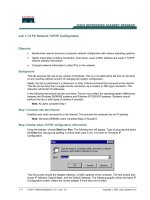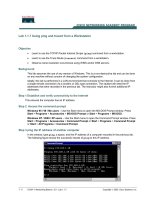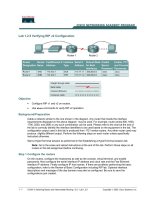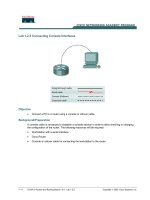Tài liệu Lab 1.1.4b Configuring NAT doc
Bạn đang xem bản rút gọn của tài liệu. Xem và tải ngay bản đầy đủ của tài liệu tại đây (352.25 KB, 6 trang )
1 - 6 CCNA 4: WAN Technologies v 3.0 - Lab 1.1.4b Copyright 2003, Cisco Systems, Inc.
Lab 1.1.4b Configuring NAT
Objective
• Configure a router to use Port Address Translation (PAT) to convert internal IP addresses,
typically private addresses, into an outside public address.
Background/Preparation
Aidan McDonald has just received a DSL line Internet connection to a local ISP in his home. The ISP
has allocated only one IP address to be used on the serial port of his remote access device. Routing
between the ISP and the home router is done using a static route between the ISP and the gateway
routers, and a default route between the gateway and the ISP routers. The ISP connection to the
Internet will be represented by a loopback address on the ISP router.
Cable a network similar to the one in the diagram. Any router that meets the interface requirements
displayed on the above diagram may be used. This includes the following and any of their possible
combinations:
• 800 series routers
• 1600 series routers
• 1700 series routers
• 2500 series routers
2 - 6 CCNA 4: WAN Technologies v 3.0 - Lab 1.1.4b Copyright 2003, Cisco Systems, Inc.
• 2600 series routers
Please refer to the chart at the end of the lab to correctly identify the interface identifiers to be used
based on the equipment in this lab. The configuration output used in this lab is produced from 1721
series routers. Any other router used may produce slightly different output. Conduct the following
steps on each router unless specifically instructed otherwise.
Start a HyperTerminal session.
Note: Refer to the erase and reload instructions at the end of this lab. Perform those steps on all
routers in this lab assignment before continuing.
Step 1 Configure the routers
Configure all of the following according to the chart:
• The hostname
• The console
• The virtual terminal
• The enable passwords
• The interfaces
If problems occur during this configuration, refer to the Network Address Translation (NAT)
configuration lab.
Step 2 Save the configuration
At the privileged exec mode prompt, on both routers, type the command copy running-config
startup-config.
Step 3 Configure the hosts with the proper IP address, subnet mask, and default gateway
Each workstation should be able to ping the attached router. If for some reason this is not the case,
troubleshoot as necessary. Check and verify that the workstation has been assigned a specific IP
address and default gateway. If running Windows 98, check using Start > Run > winipcfg. If running
Windows 2000 or higher, check using ipconfig in a DOS window.
Step 4 Verify that the network is functioning
a. From the attached hosts, ping the fastethernet interface of the default gateway router.
b. Was the ping from the first host successful?
_____________
c. Was the ping from the second host successful?
_____________
d. If the answer is no for either question, troubleshoot the router and host configurations to find the
error. Then ping again until they both are successful.
Step 5 Create a default
route
a. Add a default route from the Gateway to the ISP router. This will forward any unknown
destination address traffic to the ISP. Use the ip route command to create the default route:
Gateway(config)#ip route 0.0.0.0 0.0.0.0 200.2.2.17
b. Is the route in the routing table?
_______________________________________________
c. Try to ping from one of the workstations to the ISP serial interface IP address.
d. Was the ping successful?
____________________________________________________
3 - 6 CCNA 4: WAN Technologies v 3.0 - Lab 1.1.4b Copyright 2003, Cisco Systems, Inc.
e. Why?
__________________________________________________________________
f. What command checks the routing table contents?
_________________________________
Step 6 Define an access list that will match the inside private IP addresses
To define the access list to match the inside private addresses, use the access list command:
Gateway(config)#access-list 1 permit 10.10.10.0 0.0.0.255
Step 7 Define the PAT translation from inside list to outside address
To define the PAT translation, use the ip nat inside source command. This command with
the overload option will create port address translation using the serial 0 IP address as the base:
Gateway(config)#ip nat inside source list 1 interface serial 0 overload
Step 8 Specify the interfaces
The active interfaces on the router need to be specified as either inside or outside interfaces with
respect to PAT. To do this, use the ip nat inside or ip nat outside command:
Gateway(config)#interface fastethernet 0
Gateway(config-if)#ip nat inside
Gateway(config-if)#interface serial 0
Gateway(config-if)#ip nat outside
Step 9 Testing the configuration
a. Configure a PC on the internal LAN with the IP address 10.10.10.10/24 and a default gateway
10.10.10.1. From the PCs, ping the Internet address 172.16.1.1. If successful, Telnet to the
same IP address. Then look at the PAT translation on the gateway router, using the command
show ip nat translations.
b. What is the translation of the inside local host addresses?
______________
=
______________ ______________
=
______________
c. What does the number after the colon represent?
__________________________________
d. Why do all of the commands for PAT say NAT?
____________________________________
Upon completion of the previous steps finish the lab by doing the following:
• Logoff by typing exit
• Turn the router off
• Remove and store the cables and adapter
4 - 6 CCNA 4: WAN Technologies v 3.0 - Lab 1.1.4b Copyright 2003, Cisco Systems, Inc.
Configuration reference sheet
This sheet contains the basic configuration commands for the ISP and Gateway routers:
ISP
Router#configure terminal
Router(config)#hostname ISP
ISP(config)#enable password cisco
ISP(config)#enable secret class
ISP(config)#line console 0
ISP(config-line)#password cisco
ISP(config-line)#login
ISP(config-line)#exit
ISP(config)#line vty 0 4
ISP(config-line)#password cisco
ISP(config-line)#login
ISP(config-line)#exit
ISP(config)#interface loopback 0
ISP(config-if)#ip address 172.16.1.1 255.255.255.255
ISP(config-if)#no shutdown
ISP(config-if)#exit
ISP(config)#interface serial 0
ISP(config-if)#ip address 200.2.2.17 255.255.255.252
ISP(config-if)#no shutdown
ISP(config-if)#clockrate 64000
ISP(config)#ip route 199.99.9.32 255.255.255.224 200.2.2.18
ISP(config)#end
ISP#copy running-config startup-config
Gateway
Router#configure terminal
Router(config)#hostname Gateway
Gateway(config)#enable password cisco
Gateway(config)#enable secret class
Gateway(config)#line console 0
Gateway(config-line)#password cisco
Gateway(config-line)#login
Gateway(config-line)#exit
Gateway(config)#line vty 0 4
Gateway(config-line)#password cisco
Gateway(config-line)#login
Gateway(config-line)#exit
Gateway(config)#interface fastethernet 0
Gateway(config-if)#ip address 10.10.10.1 255.255.255.0
Gateway(config-if)#no shutdown
Gateway(config-if)#exit
Gateway(config)#interface serial 0
Gateway(config-if)#ip address 200.2.2.18 255.255.255.252
Gateway(config-if)#no shutdown
Gateway(config)#ip route 0.0.0.0 0.0.0.0 200.2.2.17
5 - 6 CCNA 4: WAN Technologies v 3.0 - Lab 1.1.4b Copyright 2003, Cisco Systems, Inc.
Erasing and reloading the router
Enter into the privileged exec mode by typing enable.
If prompted for a password, enter class (if that does not work, ask the instructor).
Router>enable
At the privileged exec mode enter the command erase startup-config.
Router#erase startup-config
The responding line prompt will be:
Erasing the nvram filesystem will remove all files! Continue? [confirm]
Press Enter to confirm.
The response should be:
Erase of nvram: complete
Now at the privileged exec mode enter the command reload.
Router(config)#reload
The responding line prompt will be:
System configuration has been modified. Save? [yes/no]:
Type n and then Enter.
The responding line prompt will be:
Proceed with reload? [confirm]
Press Enter to confirm.
In the first line of the response will be:
Reload requested by console.
After the router has reloaded the line prompt will be:
Would you like to enter the initial configuration dialog? [yes/no]:
Type n and then Enter.
The responding line prompt will be:
Press RETURN to get started!
Press Enter.
Now the router is ready for the assigned lab to be performed.









